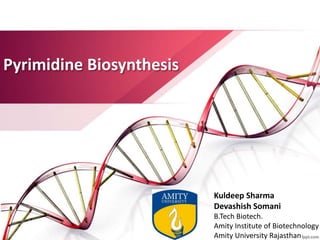
Pyrimidine Biosynthesis
- 1. Pyrimidine Biosynthesis Kuldeep Sharma Devashish Somani B.Tech Biotech. Amity Institute of Biotechnology Amity University Rajasthan
- 2. Introduction • The biosynthesis of pyrimidine is a simpler process than the purines. • Pyrimidne synthesis is a de novo synthesis pathway involving six step reactions. • The six members pyrimidine ring is made first and then attached to ribose-5-monophosphate. • This pathway results in the synthesis of Uridine-5- monophosphate (UMP). • Out of 6 enzymes involved in this pathway, 5 are present in the cytosol and one is present on the outer surface of inner mitochondrial membrane.
- 3. Biosynthetic origins of pyrimidine ring atoms Isotopic labeling experiments have shown that atoms N1, C4, C5, and C6 of the pyrimidine ring are all derived from aspartic acid, C2 arises from HCO3 , and N3 is contributed by glutamine
- 4. Background History The major breakthrough in the determination of the pathway for the de novo biosynthesis of pyrimidine ribonucleotides was the observation that mutants of the bread mold Neurospora crassa, which are unable to synthesize pyrimidines and therefore require both cytosine and uracil in their growth medium, grow normally when supplied instead with the pyrimidine orotic acid (uracil-6-carboxylic acid). This observation led to the elucidation of the following six reaction pathway for the biosynthesis of UMP
- 5. Metabolic pathway STEP 1: Synthesis of carbamoyl phosphate The first reaction of pyrimidine biosynthesis is the synthesis of carbamoyl phosphate from bicarbonate ion and the amide nitrogen of glutamine by the cytosolic enzyme carbamoyl phosphate synthetase II (CPS II). This reaction is unusual in that it does not use biotin and consumes two molecules of ATP: One provides a phosphate group and the other energizes the reaction. We have previously discussed the synthesis of carbamoyl phosphate in connection with the formation of arginine. The carbamoyl phosphate that is used to synthesize arginine via the urea cycle is synthesized by a separate mitochondrial enzyme, carbamoyl phosphate synthetase I (CPS I), which uses ammonia as its nitrogen source.
- 7. Metabolic pathway STEP 2: Synthesis of carbamoyl aspartate. Condensation of carbamoyl phosphate with aspartate to form carbamoyl aspartate is catalyzed by aspartate transcarbamylase (ATCase). This reaction occurs without need of ATP because carbamoyl phosphate is intrinsically activated.
- 9. Metabolic pathway STEP 3: Ring closure to form dihydroorotate. The third reaction of the pathway forms the pyrimidine ring yielding dihydroorotate in an intramolecular condensation catalyzed by the zinc metalloenzyme dihydroorotase.
- 10. Metabolic pathway STEP 4: Oxidation of dihydroorotate. Dihydroorotate is irreversibly oxidized to orotate by dihydroorotate dehydrogenase (DHODH). This eukaryotic enzyme, which contains FlavinMonoNucletide, is an integral membrane protein that is located on the outer surface of the inner mitochondrial membrane, where ubiquinone supplies its oxidizing power and gets converted to its reduced form. The other five enzymes of pyrimidine nucleotide biosynthesis are cytosolic in animal cells.
- 12. Metabolic pathway STEP 5: Transfer of orotate to Ribose-5-monophosphate. Orotate reacts with 5-phospho-alpha-d-ribosyl-1-pyrophosphate (PRPP) to yield orotidine-5-monophosphate (OMP) in a reaction catalyzed by orotate phosphoribosyltransferase and driven by hydrolysis of the eliminated PPi. This reaction fixes the anomeric form of pyrimidine nucleotides in the configuration. Figure: 5-phospho-alpha-d-ribosyl-1-pyrophosphate (PRPP)
- 14. Metabolic pathway STEP 6: Decarboxylation to form UMP The final reaction of the pathway is the decarboxylation of OMP by OMP decarboxylase (ODCase) to form UMP.
- 17. Synthesis of Cytosine-tri-phosphate (CTP) from UMP •Nucleoside monophosphate kinase (NMK) catalyzes transfer of Pi to UMP to form UDP; nucleoside diphosphate kinase (NDK) catalyzes transfer of Pi from ATP to UDP to form UTP •CTP is formed by amination of UTP by CTP synthetase. In animals, the amino group is donated by glutamine, whereas in bacteria it is supplied directly by ammonia.
- 18. UMP UDP ATP ADP ATP ADP UTP NMK NDK
- 19. Synthesis of Thymine Nucleotides •Thymine nucleotides are made from dUMP, which derives from dUDP, dCDP metabolism •The enzyme Thymidylate synthetase converts dUMP to dTMP through the methylation of dUMP . •The methyl group is donated by N5,N10-methylene THF •dUDPdUTPdUMPdTMP dCDPdCMPdUMPdTMP
- 21. Regulation In mammals, the pyrimidine biosynthesis is regulated at two steps; •Carbamoyl phosphate synthetase II, which is inhibited by UDP and UTP and activated by ATP and PRPP •OMP decarboxylase, for which UMP and CMP are competitive inhibitors.
